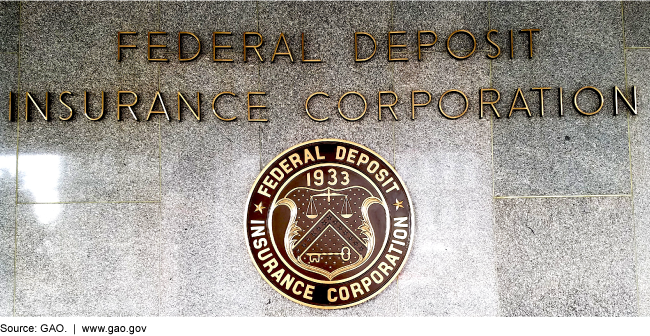Financial Company Bankruptcies: Congress and Regulators Have Updated Resolution Planning Requirements
Fast Facts
The 2007-2009 financial crisis and the failures of large, complex financial institutions led some to question the adequacy of the Bankruptcy Code for reorganizing or liquidating these institutions. In response, the Dodd-Frank Act gave the Federal Deposit Insurance Corporation authority for a regulatory alternative to bankruptcy.
We looked at some proposed changes to the code, FDIC's authority to liquidate such companies, and actions FDIC and the Federal Reserve can take to plan resolutions of companies. Since 2015, Congress has not changed the bankruptcy code but regulators have updated resolution planning requirements.

Highlights
What GAO Found
Since 2015, Congress has not changed parts of the U.S. Bankruptcy Code (Code) related to financial companies or the Orderly Liquidation Authority (OLA). However, the Federal Deposit Insurance Corporation (FDIC) and the Board of Governors of the Federal Reserve System (Federal Reserve) have updated the resolution planning process to better match resolution planning requirements to the risks of companies. OLA is a regulatory alternative to bankruptcy for resolving failed, systemically important financial institutions, and resolution plans describe how a financial company may be resolved in an orderly manner if it fails. In November 2019, FDIC and the Federal Reserve finalized amendments to the Resolution Plans Required rule, establishing different filing cycles and content requirements for resolution plans based on the asset size and risk profile of companies. Regulators also finalized other rules related to OLA and resolution planning and proposed several additional rules.
Why GAO Did This Study
The 2007–2009 financial crisis and the failures of large, complex financial companies led some financial and legal experts to question the adequacy of the U.S. Bankruptcy Code for effectively reorganizing or liquidating these companies. These experts, government officials, and members of Congress responded by proposing changes to the Code and the supervisory process leading to a bankruptcy filing. The Dodd-Frank Wall Street Reform and Consumer Protection Act (Dodd-Frank Act) established OLA as a regulatory alternative to bankruptcy. Under OLA, the Secretary of the Treasury may appoint FDIC as a receiver to resolve systemically important financial institutions. In addition to OLA, the Dodd-Frank Act requires financial companies to file periodic resolution plans with the Financial Stability Oversight Council, Federal Reserve and FDIC describing how they could be resolved in an orderly manner in the event of material financial distress or failure.
The Dodd-Frank Act also includes a provision for GAO to study, at specified intervals, the effectiveness of the Code in facilitating the orderly liquidation or reorganization of financial companies and ways to make the orderly liquidation process under the Code more effective. This report examines (1) proposed or enacted changes to the Code related to financial companies and OLA since 2015, and (2) regulatory actions related to resolution planning and OLA.
GAO reviewed proposed legislation, regulations, prior GAO reports, and agency reports and presentations on financial company bankruptcies, OLA, and resolution planning. GAO also reviewed comment letters to the 2019 proposed Resolution Plans Required rulemaking. GAO interviewed officials from the Administrative Office of the United States Courts, FDIC, and the Federal Reserve. GAO also interviewed six industry stakeholders, including academics, a consumer group, industry associations, and former regulatory officials, about the 2019 Resolution Plans Required Rule.
For more information, contact Michael Clements at (202) 512-8678 or ClementsM@gao.gov.
